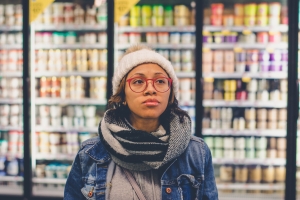![]() By Caroline Hagen
By Caroline Hagen
It’s brand planning season and many FMCG brand marketers are busy considering how to achieve the board’s 2020 marketing objectives. The world may be in turmoil, but targets still need to be negotiated, marketing plans made and budgets requested.
So should 2020 be the year you invest in a packaging refresh or a rebrand?
The question can put fear into the hearts of many a marketing director, but before you answer no, you might want to consider the value a change to your packaging could represent. We posed this question earlier this year to marketing directors and brand managers from a selection of our clients working in global and UK FMCG companies.
The top 5 reasons why they invest in packaging design, ranked in order of popularity, are that it:
- Creates brand recognition in store
- Gives their product a competitive edge
- Embodies their brand
- Keeps their brand relevant
- Helps them reach new consumers
Looking at this list, it’s surprising a packaging refresh or rebrand doesn’t appear on more marketing directors’ brand plans!
One respondent powerfully summarised their reason for investment:
‘’Packaging obviously gives an immediate impression of your product. The design is responsible for giving consumers the necessary information about your offering and USP and is sometimes the only sign of what new customers ‘should’ or ‘could’ expect of a product before purchase. The design needs to easily grab a consumer’s interest especially when that person knows nothing (to very little) of its contents. Having a good design also encourages business growth (and in return profit..hopefully) and helps increase business value and relevance.”
Another gave us an interesting insight into their reasons for investing in packaging design.
“Packaging design strengthens retailer support including in-store personnel,”
This statement highlights how important packaging design is for leverage with your customers and the interest the retailers themselves place on the role of packaging design.
Let’s take each of the top 5 benefits of great packaging design in turn and see how you might apply it to your own brand planning. I’ve included verbatim quotes from clients that supported their reasons for ranking a particular benefit.
1. Creates brand recognition in store
This quote says it all:
“The act of buying is done in the store, and the consumer must find all the distinctive elements of the brand on the pack, while differentiating himself from his competitors. You can convince the consumer to buy the product before entering the store, but if the pack is not properly executed, you may lose the sale on the shelf.”
In other words, why spend all that money on building awareness and brand affinity if the consumer doesn’t see, recognise or engage with the pack in store.

2. Gives your product a competitive edge
You’ve probably spent plenty of resource, effort and money developing a product that has a competitive advantage, it may even be revolutionary. But if the pack doesn’t reflect this point of difference to your consumer and persuade them of the benefits, you’ve wasted all this investment let alone lost valuable sales.
In the words of one respondent:
“It is the face and voice of the product, the heart of it all.”
and another “This is the first and almost only consumer touchpoint, so pack needs to attract and convince”.

3. Embodies your brand
I can’t put it better than this quote from a client respondent:
“With stagnant/reduced advertising budgets, increased media clutter, etc, it’s getting very difficult to communicate brand positioning with advertising (paid or earned). Packaging design is a marketing tool you control and one that consumers, shoppers, customers, etc all will see and hopefully (if it creates trial) engage/connect with.”
A rebrand provides the opportunity for the whole team to really delve deep into a brand’s history, values and visual equities, and may require the need to revisit brand positioning. But whatever the scenario, a packaging rebrand should create a unique, compelling and relevant brand identity that reflects the brand positioning or indeed carves out a new brand positioning.
Nicely put by one respondent:
“Capturing the essence of the brand and communicating it through the packaging in a way that resonates and so drives consideration in the customer”

4. Keeps your brand relevant
A packaging refresh can revitalise a brand that’s been around for a while. There’s no need to throw out valuable visual equities by which the brand is recognised and reassures a loyal consumer; they might just need some gentle caressing to bring them into the current zeitgeist.
As one Client respondent put it “ [the value lies in] staying relevant if [it’s an] old brand; gaining awareness if new.”
Categories are dynamic places with new products and brands launching all the time. The visual category language may have changed. A packaging identity that was current only a 2 or 3 years ago may already have lost its currency.
5. Helps us reach new consumers
This quote usefully expresses the power of packaging design:
“Packaging design is often looked at in isolation to the whole brand experience model, and given it’s the moment of truth – especially for a first time user of the brand – there is a lot of opportunity – even with small details – to create impact.”
It also helps engender loyalty and repurchase by reinforcing brand values and product USPs in the home, as described here:
“Stand out on the shelf and delivering the experience of the brand at the moment of truth, i.e. when a consumer takes it home and uses it!”

In conclusion, if any of your marketing objectives involve increases in penetration or loyalty, then why not consider a packaging refresh as a powerful tool to achieve this. And if you need to improve brand relevance or reposition the brand in any way, then pop packaging rebranding into your marketing plan.
Also, a watch out if you are investing in any form of advertising to increase awareness to drive in-store sales, make sure your packaging design is sufficiently distinctive and memorable for your target consumer to buy your product and NOT a competitor’s when they are in-store.
